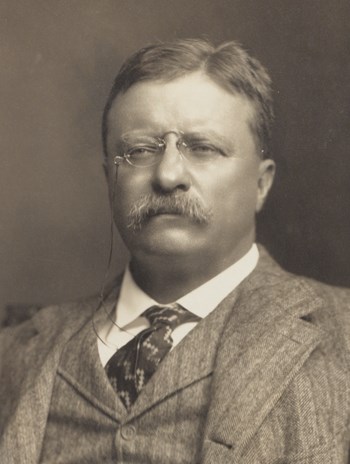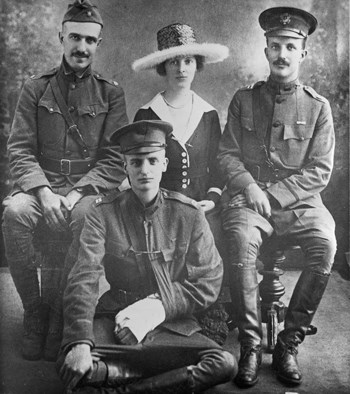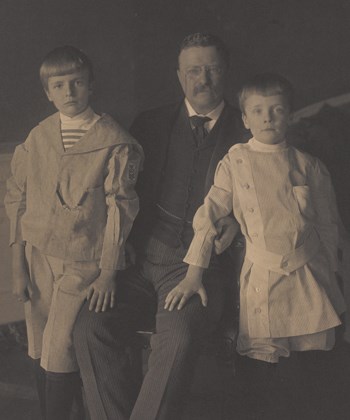Last updated: March 7, 2025
Article
The Bull Moose in Winter: Theodore Roosevelt and World War I
“I detest war. But if war came I’d have to go, and my four boys would go, too, because we have ideals in this family.”
Theodore Roosevelt

Library of Congress (LC-DIG-ppmsca-35727)
Opposed to Neutrality
As president of the United States, Theodore Roosevelt sought to raise America’s international clout. To that end, he secured the Panama Canal by aiding Colombian rebels (1904), negotiated terms of peace to end the Russo-Japanese War (1905), and launched America’s sparkling new Great White Fleet on a two year tour of the world to demonstrate America’s power (1907-9).After trading the White House for his home at Sagamore Hill in 1909, Roosevelt’s desire to lead still burned. He ran as a third party candidate in 1912. The campaign failed, leaving him with damaged friendships and bad blood with Republicans who had supported Taft. The Republican split allowed the Democrats’ Woodrow Wilson to take the presidency. While Roosevelt was still full of ideas and opinions, especially regarding a president he rarely agreed with by 1914, he acknowledged that “It is perfectly obvious that the bulk of our people are heartily tired of me.” Just as the world fell into chaos and war that year, Roosevelt saw his influence turning to impotence.
Far removed from the White House and the power of the presidency that was once his, Roosevelt believed America should prepare for war - training troops and readying the Navy - even if the nation were not directly involved in the fight. President Wilson preferred to keep America neutral, leaving a European conflict to the Europeans, declaring "There is such a thing as a man being too proud to fight." Roosevelt believed neutrality would fail as the war developed. After the Germans sank the RMS Lusitania on May 7, 1915, Roosevelt regarded America’s lack of involvement as “inconceivable.”
To Roosevelt, neutrality looked like "supine inaction." He openly criticized Wilson to anyone who would listen. Although he still had supporters, Roosevelt's ideas were heard by fewer and fewer people the farther he got from the presidency. For his part, Wilson had learned that “...the best way to treat Mr. Roosevelt is to take no notice of him. That breaks his heart and is the best punishment that can be administered.”
Wilson was finally forced to change his stance after German U-boats regularly attacked American shipping in early 1917. Wilson asked Congress for a declaration of war, and Congress obliged on April 6, 1917. However, mobilization was a long time coming, as Wilson’s desire to avoid conflict was coupled with an unwillingness to prepare for war. Roosevelt had advocated for such preparations all along, and now finally the nation seemed to be coming around. With war at hand, Roosevelt saw opportunity.
The Roosevelts Go to War
From the start of the war, Roosevelt had toyed with the notion of forming a Rough Riders-like regiment, recalling his own glory earned in the Spanish-American War. Perhaps a valiant charge would prove his worth as a man, even if he were killed in the process. In an attempt to resurrect the Rough Riders, Roosevelt’s son-in-law, Nick Longworth (R-OH), sponsored legislation to create four “special volunteer divisions.” President Wilson opposed the measure. The practical reason was that the advent of machine guns and heavy artillery made a valiant cavalry charge hopelessly futile, as many Europeans had learned the hard way at the outset of the war. However, it’s also true that Roosevelt had been acutely irritating to Wilson, and the president was not interested in offering his political enemy a path to glory. Theodore Roosevelt would not be going overseas.

Library of Congress (LC-USZ62-135060)
Instead, Roosevelt’s six children took up the cause and served where and how they could. Ted and Archie left for France on June 20, 1917, where Ted took command of the First Battalion of the 26th Infantry, 1st Division, with his younger brother under his command. The next month, Quentin, the youngest sibling, went over with the 95th aero squadron. Ethel and her husband Dick Derby went to Europe with the Red Cross, the organization to which they devoted their entire lives. Alice, wife to Nick Longworth, remained in Washington, DC to bear her considerable influence on politics at home and pass information to her father. Of Kermit, posted with the British Army in the Middle East, Theodore Roosevelt wrote, “the boy shall have the chance to serve, and if necessary be killed in the serving.” The same sentiment could apply for the rest of the family as well, for these qualities of valor and honor appealed to the Roosevelts, and had been driven into the children their entire lives.
The Roosevelt boys all served with distinction. In March 1918, Archie took a shrapnel wound while leading a platoon of troops against a German position. The wound paralyzed Archie’s left arm. He was awarded the Croix de Guerre. Kermit was awarded the British Military Cross. Ted was awarded the Silver Star and the Croix de Guerre, and suffered from the effects of gas attacks. Quentin saw action in the air, that summer scoring an aerial victory.

Library of Congress (LC-DIG-ppmsca-35758)
The Final Act
After Quentin’s death, Theodore Roosevelt’s health began to deteriorate rapidly. Although he still imagined he would be needed for the upcoming 1920 election, a lifetime of hard living was taking its toll, and the emotional drain of losing his youngest son, in whom he’d seen so much of himself, affected Theodore Roosevelt in unseen ways that cannot be measured. The war ended on November 11, 1918, though Ted and Kermit remained overseas along with Ethel’s husband Dick Derby. That Christmas, Theodore Roosevelt enjoyed the company of daughters Alice and Ethel, his recovering son Archie and wife Grace, and his granddaughter Edie Derby in the comfort of the family home at Sagamore Hill (photographed above). Then, in the early hours of January 6, 1919, Theodore Roosevelt died. Kermit wrote his mother Edith from abroad, “There never was anyone like him, and there won’t be.”
As president, Theodore Roosevelt never faced the major international crisis that Woodrow Wilson faced with the First World War. The unfortunate timing of Theodore Roosevelt’s presidency - he became the youngest US president when William McKinley was assassinated - left Roosevelt filled with ambition even after serving as president. The desire to lead was still strong, even as Roosevelt’s influence waned. Nothing thrilled Roosevelt more than a good fight, and he was largely shut out of it. It would take the lessons of World War II a generation later to prove that Roosevelt and Wilson were both right in their own ways. America did need to be prepared for war, and it needed to be an active leader in the pursuit of international peace. Oceans alone would not keep her safe, and the nation needed to prepare for war in order to prevent it.
Legacy
There are more national parks related to Theodore Roosevelt than any other president. Among the places you can visit to learn more about Theodore Roosevelt, his home at Sagamore Hill was the most important in this phase of his life. Theodore Roosevelt National Park offers a connection to Roosevelt’s youth, and his preoccupation with manly pursuits that predated his adventure with the Rough Riders. Other associated sites include Theodore Roosevelt Inaugural, Theodore Roosevelt Birthplace, Theodore Roosevelt Island, and Mount Rushmore, not to mention the 240 million acres of public lands conserved during Roosevelt’s presidency.
